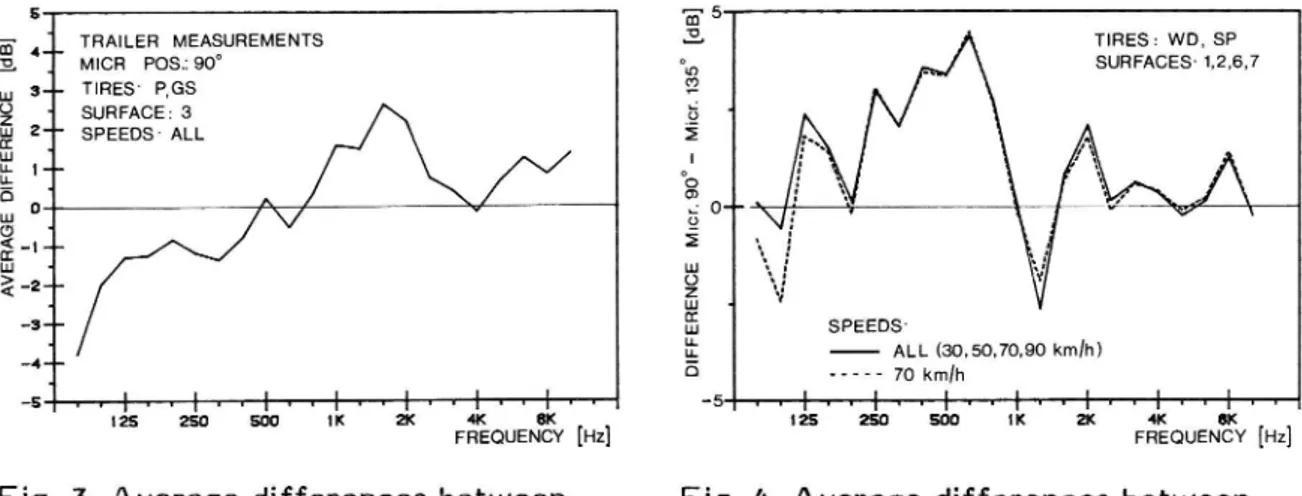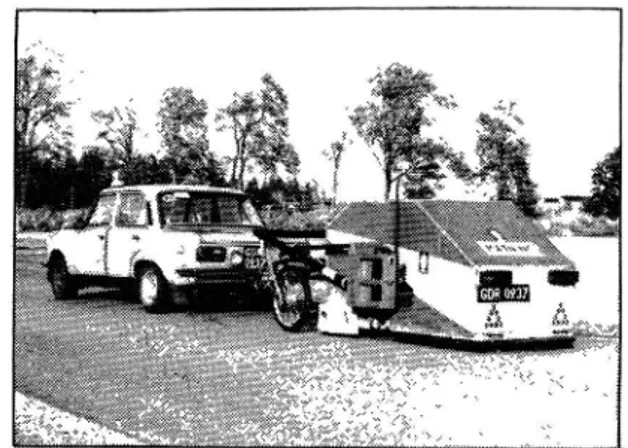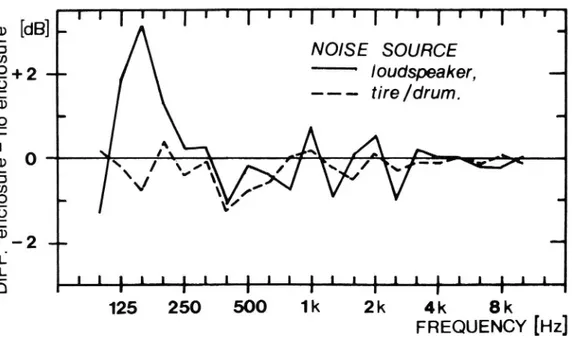V sar_ry___ck
'703
Tire/Road Noise:
Trailer Measurements in Practice
Jerzy A. Ejsmont and Ulf Sandberg
Reprint from the 7985 International Conference on Noise Contro/
Engineering (INTER NO/SE 85) in Munich, Federal Republic of
Germany, 7820 September 7985
VTI, Linköping 7985
Väg''06/7 a /(' Statens väg- och trafikinstitut (VTI) 587 07 Linköping ,IHStitUtEt Swedish Road and Traffic Research Institute. S-58 7 0 7 Linköping Sweden
%ä'tYYC
_k
103
Tire/Rcad Noise:
Trailer Measurements in Practice
Jerzy A. Ejsmcnt and Ulf Sandberg
Reprint from the 7985 International Conference on Noise Centro/
Engineering (INTER-NO/SE 85) in Munich, Federal Republic of
Germany, 78-20 September 7985
VTI, Linköping 1985
v, Väg' 06/1 af/If- Statens väg- och trafikinstitut (VTI) . 581 01 Linköping
IIIStItlItEt Swedish Roadand Traffic Research institute . S-581 0 1 Linköping Sweden
1985
llllll
'::. . i.
Ai tf ." | "I
\ \\\\\\\\ u \ \ \ t
*l iiiiiili
il
* X, r! x ON' ' iii; f'g l'ill
iii "l1)xs
-lli iii
1
iii.ixi.T
A .,_ ,
0
Intet-none
0
_. ma
m .fi-'| I! "1&2! miii'.ii|i'i lm Tillliii-iiilim'ii'ujLni
85
Limiilliiulll, till!
TIRE/ROAD NOISE: TRAILER MEASUREMENTS IN PRACTICE Jerzy A. Ejsmont Ulf Sandberg
Technical University of Gdansk Swedish Road and Traffic Research Institute
ul.Majakowskiego 11/12
5-581 01 Linköping
PL-80 952 Gdansk, POLAND SWEDEN
(presently at III. Physik. Inst., Univ. of Göttingen, BRD)
INTRODUCTION
Tire/road noise measurements have become very important during recent years due to the awareness of the problem of tire/road noise emission in free-flowing traffic. There is a demand for standardization in this field, eSpecially as various methods have been in use and results have had a poor repeatability.
The Group of Rapporteurs on Brakes and Running Gear (GRRF) within the ECE has established an ad hoc grOUp on "Measurement of tire/road noise" which recently proposed three methods for tire/road noise measurements (ref. 1). These methods are: a conventional coast by method (shortened CB), a trailer method (TR) and a laboratory drum method (DR). In the trailer method, a single test tire is mounted in a trailer with a micrOphone close to the tire and normally there is an enclosure for protection against wind and ambient noise. This method can give very fast and accurate measurements; however, it is necessary to investigate how the results compare to corresponding CB measurements and to test the practical limitations of its use. The former has been reported in ref. 2 and the latter is reported here.
The work has been done at the Swedish Road and Traffic Research Institute
(VTI), the Technical University of Gdansk (TUG) and the Drittes Physikalisches Institut at the University of Göttingen (UG).
EXPERIMENTAL DESIGN
Most measurements were made at VTI using a trailer built at TUG (fig. 6). The trailer has a wooden enclosure covered on the inside by foam "cones" (ref. 3). The micrOphone was positioned either 0.2 m outside the tire sidewall and 0.1 m above the road level in the vertical axle plane (position called 90°) or 0.2 m behind this plane (position called 135°). During the measurements 8 different tires were used: tire "P" : PIARC ref. tire with smooth tread, "S" : Firestone Cavallino 5-1, "M" : Michelin XZX, "W" : Firestone M+S Town & Country, "G" : Gislaved M+S Frost,
"GS" : Gislaved Frost with 108 studs, "WD" = DunIOp SP88 M+S, "SP" : Pirelli P3.
In a first test round made in 1983, five road surfaces were used: No. 1 aSphalt concrete sealed with NIVECIM (test track)
No. 2 rough single surface dressing (test track)
No. 3 - aSphalt concrete with medium smooth texture (test track) No. 4 - very smooth and dense aSphalt concrete (on road)
No. 5 - very rough single surface dressing (on road)
2
Ejsmont
Unfortunately it was impossible to repeat measurements in 1984 on exactly the same surfaces. In this situation surface No. 4 was replaced by a similar surface No. 7, and No. 5 by a similar surface No. 6. During the measurements the
trailer was driven at the Speeds 30, SD, 70 and 90 km/h.
Experience with the trailer showed that it was perfectly possible to make
measurements in normal traffic without interferences from passing cars. Only
heavy trucks influenced the measurements, so appropriate comments were record-ed in the commentary channel of the tape recorder to be considerrecord-ed during the data processing. At least two recordings of 4 3 length were averaged.
INFLUENCE OF THE ENCLOSURE ON ACOUSTICAL REFLECTIONS
To estimate the influence of reflections in the enclosure which covers the measuring wheel and the micrOphone two tests were performed.
The first one was made on the TUG road-wheel facility to eliminate air-flow around the micrOphone. Tires P, S, M, W and G were driven on the drum covered
with the replica road surface NE-l (ref.3) at speeds 30, so, 70 and 90 km/h with
and without the enclosure. The case without the enclosure is representing a free
field condition. The average difference between the results is presented in fig. l .
Similar results were obtained when the trailer was placed on a flat surface and a loudspeaker in the wallside of the tire was used as a noise source (solid line in fig. 1). It was concluded that the enclosure does not significantly influence the measurements for frequencies over 200 Hz.
[ ] [ I l l I l l I l ' | | | I I | I f I I | ' | l I | | I l l I I I I | T I T I I l ' I T ' cv dB _. . L 25 p - - - -l
: NOISE SOURCE % Myer. pas/yon 90 _ 1903
§+2 __ Ioudspeaker, _ * =--- Mor. posmon 135 1984 :
8 - - tire/drum. u.| __ o _ % , o " u.! -IC [xx _A A lx_ _4 E 20__ Q) 0 \ / x /\ I. s , x. --VV LI. " I q 5 /\/ ' W V V & . ! _ U) \ / __ O I 9 &, |- q 8 g ! w_2 __ __ LLI P , -1 LL- 2 15-"' I 4 % l l I l l I l l I l l I l l I l l I l l I l l l l I I 1 I l l I L L I l l I l l I j 1 I 1 125 250 500 1 k 2 k 4 k 8 k 125 250 500 1 k 2 k k 8k FREQUENCY [Hz] FREQUENCY [Hz] Fig. l. Effect on the noise of fit- Fig. 2. Mean difference between
ting an enclosure around tire and spectra of TR and CB measurements micrOphone in the TUG trailer. for two microphone positions.
INFLUENCE OF EXTERNAL WIND
Several tests performed with the trailer during windy weather showed that the enclosure is rather efficient for reducing wind noise in the microphone. Up to a
wind speed of 6 m/s the direction (up or downwind) did not influence the spectra
or the A-weighted sound levels. For a windspeed of 10-12 m/s the results obtained in the upwind direction were a few tenth of dB lower than down-wind which was Opposite to the expectations.
MICROPHONE POSITION
In 1983 the micrOphone position of 90° was used during all the trailer measurements. The correlation between the results from trailer (TR) and coast by (CB) measurements was high as reported in ref. 2. The theoretical noise level difference estimated on the base of difference in distance to the micrOphone was 20-22 dB. This was also obtained in the measurements; however, the average TR
spectra were significantly different from the corresponding CB Spectra for
3
Ejsmont 2, solid line). There was also a systematic overestimation of ca 2-4 dB of low
frequencies at the expense of high frequencies.
In 1984 the micrOphone holder was rebuilt and the microphone position of 135° was introduced. Some measurements were also repeated at the microphone position 90° to compare the results. The results obtained in 1984 with the micrOphone position 900 were slightly different from those in 1983 for the frequency range 1-2.5 kHz, see fig. 3. The difference was most probably caused by the new micrOphone holder. By checking the CB measurements both of those years it was possible to see that there were no changes in surface and tire pr0perties.
(n
E'
E 4__ TRAILER MEASUREMENTS & TIRES: wo, SP
g _ MICR POS.: 90° om SURFACES-1,2,6,7
m 3-4 TIRES' Res c:.: % ' SURFACE: 3 /_/\ få Lu 2 SPEEDS ALL 2 /.\/\ (I , :. LU | / '-L |__ a '. LL . /\/ 8 " A D a, _r g °. AV V ;; O ' V
é-t r
E
LU ' LU 2-2" %[U _3.._ E SPEEDS-' ä _ ALL (3o,5o.7o,9o km/h) "4": O --- 70 km/h [ l l L l | L : I l l l l 1 l "5 'l"l"l*'l"l"f"l" v 'l*'|"I*'I"r"T**I" l 25 250 500 l K 2K 4K BK I 25 250 500 1K 2K 4K BK FREQUENCY [Hz] FREQUENCY [Hz]Fig. 3. Average differences between Fig. 4. Average differences between measurements made in 1984 and 1983 the two micrOphone positions
Fig. 4 shows the difference between the micrOphone positions 90° and 135° obtained in 1984 for the tires WD and SP, averaged over the surfaces 1,2,6,7 and all speeds. It is clearly seen that the position 90° gives 2-4 dB higher levels at 300 800 Hz than 135°. Thus, by using the latter position the previously mentioned overestimation of the noise at these frequencies is eliminated.
Is this the case also for a greater range of tires and roads? Fig. 2, which is based on measurements on tires different from those used for fig. 4, Shows that the answer is yes. Fig. 2 which shows the difference between the methods, is based on 30 tire/road combinations at 4 Speeds covering a large range of tires and roads. The average difference between the methods (TR - CB) is smaller and "flatter" in the case of 135° micrOphone position, and a study of the individual results indicate that this feature is basically the same for different tires. Then it can be concluded that the results obtained in the micrOphone position 135° are more similar to coast by (CB) measurements.
BACKGROUND NOISE
The task of measuring background noise on the trailers intended for tire/road noise tests is very difficult. In general, only an upper limit for the true background noise can be obtained. There are two major methods. The first is the lifted or removed wheel principle where the measuring wheel is raised from its normal position, after which the "desired" noise disappears and the background remains. To make such a test the "Tiresonic Mk2" trailer was equipped with two additional wheels located outside the enclosure. Unfortunately, it was impossible to obtain a greater distance from the micrOphone to the nearest extra wheel than twice the distance from micrOphone to measuring tire. See ref. 4.
The other method is the "quiet tire/road combination principle" where the most quiet tire and the most quiet road surface are used even if they are of extreme and abnormal construction. With this method it is only possible to
4
Ejsmont
estimate an upper limit for the background noise, as some noise from the measuring wheel inevitably remains.
To perform this method the trailer was driven over a special porous rubber
surface. Two smooth tires were used during the experiment, one of them filled
with solid polyurethane instead of air (ref. 4). Work is in progress at UG in
Germany to manufacture a "super low-noise" surface for such tests.
The true background noise is likely to be lower than shown in any of the mentioned methods, so it is justified to combine the results of both methods and take the lowest levels obtained as a new upper limit to the true background noise. In figure 5 such "background noise" is compared with some "normal" measure ments for which the S/N ratio was expected to be critical. The minimum S/N ratio is generally at least 10 dB(A) for "normal" tires (tire P is not "normal").
[dB] Ada, SPEED 70kndh ** " ,f*=% AMCR.POS sd 80 g. J. 70... Tl-60_. J
- mIN. BHCKGROUND NOISE I ... TIRE p ROHD NO.l
504 --- TIRE P ROHD N0.3 J
TIRE P ROHD NO.? . TIRE SP RORD No.1 --- TIRE sr ROHD No.7
40fl rffiffia filfflfiffif.
125 250 500 IK 2K 4K BK
FREQUENCY[HÅ
Fig. 5. The upper limit of background Fig. 6. The trailer "Tiresonic MkZ"
noise and some selected tire/road noise from TUG Spectra
CONCLUSIONS
By using an enclosure around test tire and micrOphone the influence of external wind and airflow can be reduced very much. For the TUG trailer a wind
56 m/s can be accepted.
The acoustical reflections in the trailer enclosure can be reduced by
absorp-tive lining. In the TUG trailer reflections are negligible within ZOO-10000 Hz.
The micrOphone location is important. A position 1350 (see text) is the best when Spectral similarity with coast-by measurements is desired.
By using an enclosure the problem of background noise can be largely reduced. However, this noise is difficult to measure. For the TUG trailer a S/N ratio of min. 10 dB(A) was obtained when measuring "summer" tires on quiet road surfaces and when combining background noise measurements made by two methods.
It is concluded that the problems of the trailer technique are possible to solve, implying that the trailer technique can be an alternative to the coast-by method.
REFERENCES
1. GRRF Adhoc Group on methods for measurement of tyre/road noise: "Methods for measurement of tyre/road noise -First proposal for a provisional methodology. Revised according to meeting 1985-03-21/22".
2. U. Sandberg, J.A. Ejsmont: "Three Basic Methods for Measurement of Tire/Road Noise", VTI preprint No. 99, Swedish Road and Traffic Research Institute, Linköping, Sweden (also proceedings of INTER-NOISE 84, Honolulu, USA) (1984). 3. J.A. Ejsmont: "Comparison of Road and Laboratory Measurements and Influence of some Tire Parameters on
Generation of Sound", VTI report No. 244A. Swedish Road and Traffic Research Institute (1982).
4. J.A. Ejsmont, U. Sandberg: "Background Noise Estimation for Tire/Road Noise Measurements Using the Trailer Method", VTI meddelande No. 441A Swedish Road and Traffic Research Institute (1985).
W' IV ' jsmont APPENDIX Enlarged figures
m m jsmont
ll lj lllrllliltlrrlj*11
9 [dB] _
T
I
_
: NOISE SOURCE34.2 __
Ioudspeaker,
-8
tire/drum.
cuo .. c I a) O5
m O .. 6C cu_2 __ __ u. %; 11%11:|1:1|%1|%11%11%11 125 250 500 1k 2k 4k 8kFREQUENCY [Hz]
Fig. 1 Effect on the noise of fitting an enclosure around the tire and microphone in the TUG trailer
rT|rllll|lr]rlllT|11]||
"E' 25-+
_ Micr. position 901 1983 _
:E. - Micr. position 135 1984
-E%
:
t
-a ..
s
-(I _.- i .. UJ 20u ,. i _&
I
-D
' !
z
" l
ES
t :
"
2 15- - ;
-+
llLllllllllllllllllJlll I | | I l l l 125 250 500 1k 2k 4k Bk FREQUENCY [Hz] w Mean difference between spectra of TR and CB measurements for two7 Ejsmont
TRAILER MEASUREMENTS
MICR. Pos: 90°
s..-_ TIRES: Res
-
SURFACE:3
27 - SPEEDS: ALL
AV
ER
AG
E
DI
FF
ER
EN
CE
[d
B]
Q .. . J l l>
_2__ _3__ _4__ 1 1 1 _5 l r ][ I I % I l l I I [ I I r I I lr I I || r 125 250 500 1K 2K 4K BKFREQUENCY [Hz]
Fig. 3 Average differences between measurements made in 1984 and 1983
E' 5
2-
TIRES: WD, SP
0SURFACES: 1,2,6,7
DI
FF
ER
EN
CE
Mi
cr
.9
o°
Mi
cr
.
13
5
SPEEDS:_
ALL (30,5o,7o,9o km/h)
--- 70 kmlh
;; l l L [ L l 1 "u I 1 T 'I T | I I I i I T I I | I I T I I I I I 125 250 500 IK 2K 4K BKFREQUENCY [Hz]
jsmont
dB
_
*** x
SPEED: 70 km/h
«ps/ xx [;t/(Få
..-. /\/MICR. POS. 90
_ 0 ' ' .--'1 ) .. ' \80 1-
.../ få?" ff .
(/.. = - .. - -."läxa-"' "X
_.vi \*
\/ . Q'. \\\ \ \\ 4L- J \ \ s 4 T \\ \70_r
J
\\_
\ .
J
?
--T..\\\
60.T
J
?
MIN. BHCKGROUND NOISE
=
.m_mumu.
TIRE p
ROHD NO.1
501-
---- TIRE P ROHD N0.3
J
- -- -
-
TIRE P
ROHD NO.?
1»
-
TIRE SP ROHD No.1
*
-- -- - --
TIRE SP ROHD NO.?
40
%:'::i:4fr:f%:f+%i%:i+:
125 250 500 IK 2K 4K BK
FREQUENCY[HZ
F'g. 5 The upper limit of background noise and some selected tire/road noise spectra
. vi; - {v
A 5 W"
oc" m.
P-The trailer "Tiresonic Mk2" from TUG




